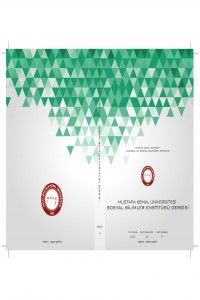BİLİMSEL BİLGİNİN TEORİYE BAĞLI ÖZNEL YAPISI: “EVRİM TEORİLERİ” ETKİNLİĞİ VE SONUÇLARI
Fen eğitimi alanındaki birçok reform çalışması bilimin doğasının öğrenciler tarafından anlaşılmasını bir hedef olarak belirlemiştir. Bilimsel bilginin bazı temel karakteristik özellikleri vardır. Bunlardan biride bilimsel bilginin sübjektif olmasıdır. Bu çalışmada bilimsel bilginin sübjektif olması yani öznel ve teoriye bağımlı yapısı üzerinde durulmuştur. Bilim insanları bilimsel çalışmalarını yaparken ön bilgilerinden, inançlarından, tecrübelerinden, almış oldukları eğitimden etkilenirler. Bu çalışmanın amacı ilköğretim fen bilgisi öğretmen adaylarının bilimsel bilginin sübjektif olmasına yönelik görüşlerinin doğrudan-yansıtıcı ve araştırmaya dayalı laboratuar öğretimi ile gelişiminin incelenmesidir. Bu çalışmada nitel araştırma yöntemi kullanılmıştır. Laboratuarda yapılan etkinlikten sonra öğretmen adaylarının deneyimlerinin anlaşılması ve bilimsel bilginin sübjektif olması hakkındaki gelişimlerinin belirlenmesi için yazılı dokümanlar toplanmıştır. Etkinliğin sonunda öğretmen adaylarıyla mülakat yapılmıştır. Laboratuar uygulamasından sonra öğretmen adaylarını bilim insanlarının kişisel tercihlerinin ve aldıkları eğitimin onların çalışmalarını etkileyeceğine değinmişlerdir. Ayrıca bilim insanlarının araştırmalarını yaparken var olan teorilerden etkilendiklerini bununda bilimde sübjektifliğe neden olduğunu, bundan dolayı da bilimsel bilginin teori-temelli olduğunu belirtmişlerdir.
Anahtar Kelimeler:
Bilimin doğası, Bilginin öznel yapısı, Sorgulayıcı öğretim, Fen bilgisi öğretmen adayları
___
- Abd-El-Khalick, F. & Lederman, N. G. (2000). “Improving science teachers' conceptions of nature of science a critical review of the literature.” Journal of Science Education, 22(7), 665-701.
- Abd-El-Khalick, F. (2001). “Embedding nature of science instruction in preservice elementary science courses: Abandoning scientism, but…” Journal of Science Teacher Education, 12(3), 215-233.
- Abd-El-Khalick, F., & Akerson, V. L. (2004). “Learning as conceptual change: Factors that mediate the development of preservice elementary teachers' views of nature of science.” Science Education, 88(5), 785-810.
- Abd-El-Khalick, F., Bell, R. L., & Lederman, N. G. (1998). “The nature of science and instructional practice: Making the unnatural natural.” Science Education, 82(4), 417-436.
- Akerson, V. L., Abd-El-Khalick, F., & Lederman, N. G. (2000). “Influence of a reflective explicit activity-based approach on elementary teachers' conceptions of nature of science.” Journal of Research in Science Teaching, 37(4), 295-317.
- Akerson, V.L., & Hanuscin, D. (2007). “Teaching the nature of science through inquiry: Results of a three-year professional development program.” Journal of Research in Science Teaching 44(5), 653-680.
- Akgul, E. (2006). “Teaching science in an inquiry-based learning environment: what it means for pre-service elementary science teachers.” Eurasia Journal of Mathematics, Science and Technology Education, 2(1). 71-81.
- American Association for the Advancement of Science (AAAS). (1990). Science for all Americans. New York: Oxford University Press.
- American Association for the Advancement of Science (AAAS). (1993). Benchmarks for science literacy: A Project 2061 report. New York: Oxford University Press.
- Bybee, R. W. (1997). Achieving scientific literacy: From purposed to practices. Portsmouth, NH: Heinemann.
- Celik, S. & Bayrakceken, S. (2006). “The Effect of a “Science, Technology and Society” Course on Prospective Teachers' Conceptions of the Nature of Science.” Research in Science and Technological Education, 24(2), 255-27.
- Hanuscin, D., Phillipson-Mower, T., & Akerson, V.L. (2006) “Integrating nature of science instruction into a physical science content course for teachers: NOS views of teaching assistants.” Science Education 90(5), 912-935.
- LeCompte, M., & Priessle, J. (1993). Ethnography and qualitative design in educational research. San Diego: Academic Press.
- Lederman N. G., Abd-El-Khalick, F., Bell, R. L., Schwartz, R. S. (2002). “Views of nature of science questionnaire: Toward a valid and meaningful assessments of learners' conceptions of nature of science.” Journal of Research in Science Teaching, 39(6), 497-521.
- Lederman, N. G., & Abd-El-Khalick, F. (1998). Avoiding de-natured science: Activities that promote understanding of the nature of science. In McComas, W. (Ed.), The nature of science in science education: Rationales and strategies (pp. 83-126). Dordercht, The Netherlands: Kluwer Academic.
- Lederman, N. G. (1992). “Students' and teachers' conceptions about the nature of science: A review of the research.” Journal of Research in Science Teaching, 29, 331-359.
- Lederman, N. G. (2007). Nature of science: Past, present, and future. In Abell, S. K., & Lederman, N. G. (Eds.), Handbook of research on science education (pp. 831-879). Mahwah, NJ: Lawrence Erlbaum Associates.
- Marshall, C., & Rossman, G. B. (2006). Designing qualitative research (4th ed.). Thousand Oaks, CA: Sage.
- Milli Eğitim Bakanlığı. (2004). İlköğretim fen ve teknoloji dersi müfredatı. Ankara, Türkiye: Milli Eğitim Bakanlığı.
- National Academy of Sciences. (1998) Teaching about evolution and the nature of science. Washington DC: National Academy Press.
- National Research Council. (1996). National science education standards. Washington, DC: National Academic Press.
- Palmquist, B. C., &Finley, F. N. (1997). “Preservice teachers' views of the nature of science during a postbaccalaurate science teaching program.” Journal of Research in Science Teaching, 34(6), 595-615.
- Sandoval, W. A., & Morrison, K. (2003). “High school students' ideas about theories and theory change after a biological inquiry unit.” Journal of Research in Science Teaching, 40(4), 369-392.
- Schwartz, R., Lederman, N. G., & Crawford, B. (2004). “Developing views of nature of science in an authentic context: An explicit approach to bridging the gap between nature of science and scientific inquiry.” Science Education, 88, 610-645.
- Tasar, M.F. (2006). “Probing Preservice Teachers' Understandings of Scientific Knowledge by Using a Vignette in Conjunction with a Paper and Pencil Test,” Eurasia Journal of Mathematics, Science and Technology Education, 2(1), 53-70.
- Başlangıç: 2004
- Yayıncı: Hatay Mustafa Kemal Üniversitesi
